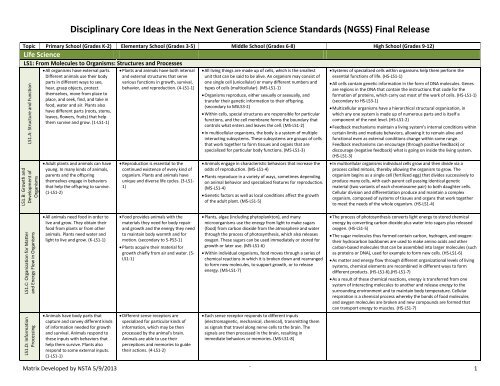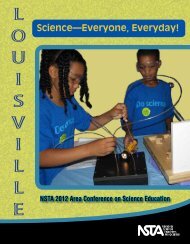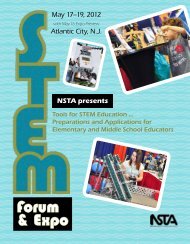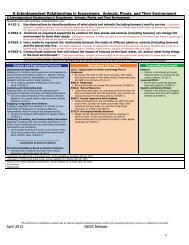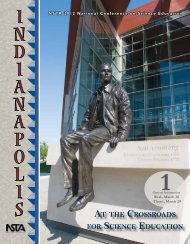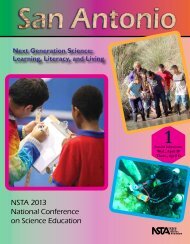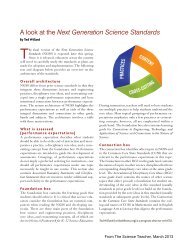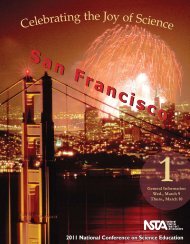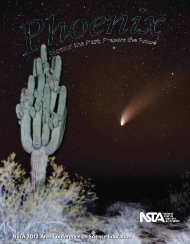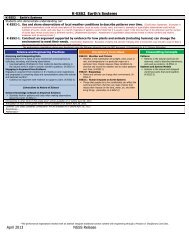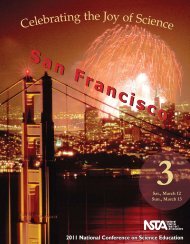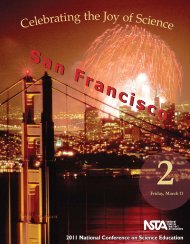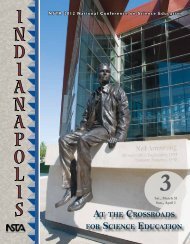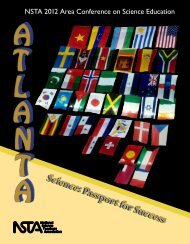Matrix of Disciplinary Core Ideas in NGSS
Matrix of Disciplinary Core Ideas in NGSS
Matrix of Disciplinary Core Ideas in NGSS
You also want an ePaper? Increase the reach of your titles
YUMPU automatically turns print PDFs into web optimized ePapers that Google loves.
<strong>Discipl<strong>in</strong>ary</strong> <strong>Core</strong> <strong>Ideas</strong> <strong>in</strong> the Next Generation Science Standards (<strong>NGSS</strong>) F<strong>in</strong>al Release<br />
Topic Primary School (Grades K-2) Elementary School (Grades 3-5) Middle School (Grades 6-8) High School (Grades 9-12)<br />
Life Science<br />
LS1: From Molecules to Organisms: Structures and Processes<br />
LS1.A: Structure and Function<br />
LS1.B: Growth and<br />
Development <strong>of</strong><br />
Organisms<br />
• All organisms have external parts.<br />
Different animals use their body<br />
parts <strong>in</strong> different ways to see,<br />
hear, grasp objects, protect<br />
themselves, move from place to<br />
place, and seek, f<strong>in</strong>d, and take <strong>in</strong><br />
food, water and air. Plants also<br />
have different parts (roots, stems,<br />
leaves, flowers, fruits) that help<br />
them survive and grow. (1-LS1-1)<br />
• Adult plants and animals can have<br />
young. In many k<strong>in</strong>ds <strong>of</strong> animals,<br />
parents and the <strong>of</strong>fspr<strong>in</strong>g<br />
themselves engage <strong>in</strong> behaviors<br />
that help the <strong>of</strong>fspr<strong>in</strong>g to survive.<br />
(1-LS1-2)<br />
• Plants and animals have both <strong>in</strong>ternal<br />
and external structures that serve<br />
various functions <strong>in</strong> growth, survival,<br />
behavior, and reproduction. (4-LS1-1)<br />
• Reproduction is essential to the<br />
cont<strong>in</strong>ued existence <strong>of</strong> every k<strong>in</strong>d <strong>of</strong><br />
organism. Plants and animals have<br />
unique and diverse life cycles. (3-LS1-<br />
1)<br />
• All liv<strong>in</strong>g th<strong>in</strong>gs are made up <strong>of</strong> cells, which is the smallest<br />
unit that can be said to be alive. An organism may consist <strong>of</strong><br />
one s<strong>in</strong>gle cell (unicellular) or many different numbers and<br />
types <strong>of</strong> cells (multicellular). (MS-LS1-1)<br />
• Organisms reproduce, either sexually or asexually, and<br />
transfer their genetic <strong>in</strong>formation to their <strong>of</strong>fspr<strong>in</strong>g.<br />
(secondary to MSLS3-2)<br />
• With<strong>in</strong> cells, special structures are responsible for particular<br />
functions, and the cell membrane forms the boundary that<br />
controls what enters and leaves the cell. (MS-LS1-2)<br />
• In multicellular organisms, the body is a system <strong>of</strong> multiple<br />
<strong>in</strong>teract<strong>in</strong>g subsystems. These subsystems are groups <strong>of</strong> cells<br />
that work together to form tissues and organs that are<br />
specialized for particular body functions. (MS-LS1-3)<br />
• Animals engage <strong>in</strong> characteristic behaviors that <strong>in</strong>crease the<br />
odds <strong>of</strong> reproduction. (MS-LS1-4)<br />
• Plants reproduce <strong>in</strong> a variety <strong>of</strong> ways, sometimes depend<strong>in</strong>g<br />
on animal behavior and specialized features for reproduction.<br />
(MS-LS1-4)<br />
• Genetic factors as well as local conditions affect the growth<br />
<strong>of</strong> the adult plant. (MS-LS1-5)<br />
• Systems <strong>of</strong> specialized cells with<strong>in</strong> organisms help them perform the<br />
essential functions <strong>of</strong> life. (HS-LS1-1)<br />
• All cells conta<strong>in</strong> genetic <strong>in</strong>formation <strong>in</strong> the form <strong>of</strong> DNA molecules. Genes<br />
are regions <strong>in</strong> the DNA that conta<strong>in</strong> the <strong>in</strong>structions that code for the<br />
formation <strong>of</strong> prote<strong>in</strong>s, which carry out most <strong>of</strong> the work <strong>of</strong> cells. (HS-LS1-1)<br />
(secondary to HS-LS3-1)<br />
• Multicellular organisms have a hierarchical structural organization, <strong>in</strong><br />
which any one system is made up <strong>of</strong> numerous parts and is itself a<br />
component <strong>of</strong> the next level. (HS-LS1-2)<br />
• Feedback mechanisms ma<strong>in</strong>ta<strong>in</strong> a liv<strong>in</strong>g system’s <strong>in</strong>ternal conditions with<strong>in</strong><br />
certa<strong>in</strong> limits and mediate behaviors, allow<strong>in</strong>g it to rema<strong>in</strong> alive and<br />
functional even as external conditions change with<strong>in</strong> some range.<br />
Feedback mechanisms can encourage (through positive feedback) or<br />
discourage (negative feedback) what is go<strong>in</strong>g on <strong>in</strong>side the liv<strong>in</strong>g system.<br />
(HS-LS1-3)<br />
• In multicellular organisms <strong>in</strong>dividual cells grow and then divide via a<br />
process called mitosis, thereby allow<strong>in</strong>g the organism to grow. The<br />
organism beg<strong>in</strong>s as a s<strong>in</strong>gle cell (fertilized egg) that divides successively to<br />
produce many cells, with each parent cell pass<strong>in</strong>g identical genetic<br />
material (two variants <strong>of</strong> each chromosome pair) to both daughter cells.<br />
Cellular division and differentiation produce and ma<strong>in</strong>ta<strong>in</strong> a complex<br />
organism, composed <strong>of</strong> systems <strong>of</strong> tissues and organs that work together<br />
to meet the needs <strong>of</strong> the whole organism. (HS-LS1-4)<br />
LS1.C: Organization for Matter<br />
and Energy Flow <strong>in</strong> Organisms<br />
LS1.D: Information<br />
Process<strong>in</strong>g<br />
• All animals need food <strong>in</strong> order to<br />
live and grow. They obta<strong>in</strong> their<br />
food from plants or from other<br />
animals. Plants need water and<br />
light to live and grow. (K-LS1-1)<br />
• Animals have body parts that<br />
capture and convey different k<strong>in</strong>ds<br />
<strong>of</strong> <strong>in</strong>formation needed for growth<br />
and survival. Animals respond to<br />
these <strong>in</strong>puts with behaviors that<br />
help them survive. Plants also<br />
respond to some external <strong>in</strong>puts.<br />
(1-LS1-1)<br />
• Food provides animals with the<br />
materials they need for body repair<br />
and growth and the energy they need<br />
to ma<strong>in</strong>ta<strong>in</strong> body warmth and for<br />
motion. (secondary to 5-PS3-1)<br />
• Plants acquire their material for<br />
growth chiefly from air and water. (5-<br />
LS1-1)<br />
• Different sense receptors are<br />
specialized for particular k<strong>in</strong>ds <strong>of</strong><br />
<strong>in</strong>formation, which may be then<br />
processed by the animal’s bra<strong>in</strong>.<br />
Animals are able to use their<br />
perceptions and memories to guide<br />
their actions. (4-LS1-2)<br />
• Plants, algae (<strong>in</strong>clud<strong>in</strong>g phytoplankton), and many<br />
microorganisms use the energy from light to make sugars<br />
(food) from carbon dioxide from the atmosphere and water<br />
through the process <strong>of</strong> photosynthesis, which also releases<br />
oxygen. These sugars can be used immediately or stored for<br />
growth or later use. (MS-LS1-6)<br />
• With<strong>in</strong> <strong>in</strong>dividual organisms, food moves through a series <strong>of</strong><br />
chemical reactions <strong>in</strong> which it is broken down and rearranged<br />
to form new molecules, to support growth, or to release<br />
energy. (MS-LS1-7)<br />
• Each sense receptor responds to different <strong>in</strong>puts<br />
(electromagnetic, mechanical, chemical), transmitt<strong>in</strong>g them<br />
as signals that travel along nerve cells to the bra<strong>in</strong>. The<br />
signals are then processed <strong>in</strong> the bra<strong>in</strong>, result<strong>in</strong>g <strong>in</strong><br />
immediate behaviors or memories. (MS-LS1-8)<br />
• The process <strong>of</strong> photosynthesis converts light energy to stored chemical<br />
energy by convert<strong>in</strong>g carbon dioxide plus water <strong>in</strong>to sugars plus released<br />
oxygen. (HS-LS1-5)<br />
• The sugar molecules thus formed conta<strong>in</strong> carbon, hydrogen, and oxygen:<br />
their hydrocarbon backbones are used to make am<strong>in</strong>o acids and other<br />
carbon-based molecules that can be assembled <strong>in</strong>to larger molecules (such<br />
as prote<strong>in</strong>s or DNA), used for example to form new cells. (HS-LS1-6)<br />
• As matter and energy flow through different organizational levels <strong>of</strong> liv<strong>in</strong>g<br />
systems, chemical elements are recomb<strong>in</strong>ed <strong>in</strong> different ways to form<br />
different products. (HS-LS1-6),(HS-LS1-7)<br />
• As a result <strong>of</strong> these chemical reactions, energy is transferred from one<br />
system <strong>of</strong> <strong>in</strong>teract<strong>in</strong>g molecules to another and release energy to the<br />
surround<strong>in</strong>g environment and to ma<strong>in</strong>ta<strong>in</strong> body temperature. Cellular<br />
respiration is a chemical process whereby the bonds <strong>of</strong> food molecules<br />
and oxygen molecules are broken and new compounds are formed that<br />
can transport energy to muscles. (HS-LS1-7)<br />
<strong>Matrix</strong> Developed by NSTA 5/9/2013 ` 1
Topic Primary School (Grades K-2) Elementary School (Grades 3-5) Middle School (Grades 6-8) High School (Grades 9-12)<br />
LS2: Ecosystems: Interactions, Energy, and Dynamics<br />
• Plants depend on water and light<br />
to grow. (2-LS2-1)<br />
LS2.A: Interdependent Relationships<br />
<strong>in</strong> Ecosystems<br />
LS2.B: Cycles <strong>of</strong> Matter and Energy Transfer <strong>in</strong><br />
Ecosystems<br />
LS2.C: Ecosystem Dynamics,<br />
Function<strong>in</strong>g, and Resilience<br />
• Plants depend on animals for<br />
poll<strong>in</strong>ation or to move their seeds<br />
around. (2-LS2-2)<br />
• The food <strong>of</strong> almost any k<strong>in</strong>d <strong>of</strong><br />
animal can be traced back to plants.<br />
Organisms are related <strong>in</strong> food webs<br />
<strong>in</strong> which some animals eat plants for<br />
food and other animals eat the<br />
animals that eat plants. Some<br />
organisms, such as fungi and<br />
bacteria, break down dead<br />
organisms (both plants or plants<br />
parts and animals) and therefore<br />
operate as “decomposers.”<br />
Decomposition eventually restores<br />
(recycles) some materials back to<br />
the soil. Organisms can survive only<br />
<strong>in</strong> environments <strong>in</strong> which their<br />
particular needs are met. A healthy<br />
ecosystem is one <strong>in</strong> which multiple<br />
species <strong>of</strong> different types are each<br />
able to meet their needs <strong>in</strong> a<br />
relatively stable web <strong>of</strong> life. Newly<br />
<strong>in</strong>troduced species can damage the<br />
balance <strong>of</strong> an ecosystem. (5-LS2-1)<br />
• Matter cycles between the air and<br />
soil and among plants, animals, and<br />
microbes as these organisms live<br />
and die. Organisms obta<strong>in</strong> gases,<br />
and water, from the environment,<br />
and release waste matter (gas,<br />
liquid, or solid) back <strong>in</strong>to the<br />
environment. (5-LS2-1)<br />
• When the environment changes <strong>in</strong><br />
ways that affect a place’s physical<br />
characteristics, temperature, or<br />
availability <strong>of</strong> resources, some<br />
organisms survive and reproduce,<br />
others move to new locations, yet<br />
others move <strong>in</strong>to the transformed<br />
environment, and some die.<br />
(secondary to 3-LS4-4)<br />
• Organisms, and populations <strong>of</strong> organisms, are dependent on<br />
their environmental <strong>in</strong>teractions both with other liv<strong>in</strong>g<br />
th<strong>in</strong>gs and with nonliv<strong>in</strong>g factors. (MS-LS2-1)<br />
• In any ecosystem, organisms and populations with similar<br />
requirements for food, water, oxygen, or other resources<br />
may compete with each other for limited resources, access<br />
to which consequently constra<strong>in</strong>s their growth and<br />
reproduction. (MS-LS2-1)<br />
• Growth <strong>of</strong> organisms and population <strong>in</strong>creases are limited<br />
by access to resources. (MS-LS2-1)<br />
• Similarly, predatory <strong>in</strong>teractions may reduce the number <strong>of</strong><br />
organisms or elim<strong>in</strong>ate whole populations <strong>of</strong> organisms.<br />
Mutually beneficial <strong>in</strong>teractions, <strong>in</strong> contrast, may become so<br />
<strong>in</strong>terdependent that each organism requires the other for<br />
survival. Although the species <strong>in</strong>volved <strong>in</strong> these competitive,<br />
predatory, and mutually beneficial <strong>in</strong>teractions vary across<br />
ecosystems, the patterns <strong>of</strong> <strong>in</strong>teractions <strong>of</strong> organisms with<br />
their environments, both liv<strong>in</strong>g and nonliv<strong>in</strong>g, are shared.<br />
(MS-LS2-2)<br />
• Food webs are models that demonstrate how matter and<br />
energy is transferred between producers, consumers, and<br />
decomposers as the three groups <strong>in</strong>teract with<strong>in</strong> an<br />
ecosystem. Transfers <strong>of</strong> matter <strong>in</strong>to and out <strong>of</strong> the physical<br />
environment occur at every level. Decomposers recycle<br />
nutrients from dead plant or animal matter back to the soil<br />
<strong>in</strong> terrestrial environments or to the water <strong>in</strong> aquatic<br />
environments. The atoms that make up the organisms <strong>in</strong> an<br />
ecosystem are cycled repeatedly between the liv<strong>in</strong>g and<br />
nonliv<strong>in</strong>g parts <strong>of</strong> the ecosystem. (MS-LS2-3)<br />
• Ecosystems are dynamic <strong>in</strong> nature; their characteristics can<br />
vary over time. Disruptions to any physical or biological<br />
component <strong>of</strong> an ecosystem can lead to shifts <strong>in</strong> all its<br />
populations. (MS-LS2-4)<br />
• Biodiversity describes the variety <strong>of</strong> species found <strong>in</strong> Earth’s<br />
terrestrial and oceanic ecosystems. The completeness or<br />
<strong>in</strong>tegrity <strong>of</strong> an ecosystem’s biodiversity is <strong>of</strong>ten used as a<br />
measure <strong>of</strong> its health. (MS-LS2-5)<br />
• Ecosystems have carry<strong>in</strong>g capacities, which are limits to the numbers <strong>of</strong><br />
organisms and populations they can support. These limits result from<br />
such factors as the availability <strong>of</strong> liv<strong>in</strong>g and nonliv<strong>in</strong>g resources and from<br />
such challenges such as predation, competition, and disease. Organisms<br />
would have the capacity to produce populations <strong>of</strong> great size were it not<br />
for the fact that environments and resources are f<strong>in</strong>ite. This fundamental<br />
tension affects the abundance (number <strong>of</strong> <strong>in</strong>dividuals) <strong>of</strong> species <strong>in</strong> any<br />
given ecosystem. (HS-LS2-1),(HSLS2-2)<br />
• Photosynthesis and cellular respiration (<strong>in</strong>clud<strong>in</strong>g anaerobic processes)<br />
provide most <strong>of</strong> the energy for life processes. (HS-LS2-3)<br />
• Plants or algae form the lowest level <strong>of</strong> the food web. At each l<strong>in</strong>k upward<br />
<strong>in</strong> a food web, only a small fraction <strong>of</strong> the matter consumed at the lower<br />
level is transferred upward, to produce growth and release energy <strong>in</strong><br />
cellular respiration at the higher level. Given this <strong>in</strong>efficiency, there are<br />
generally fewer organisms at higher levels <strong>of</strong> a food web. Some matter<br />
reacts to release energy for life functions, some matter is stored <strong>in</strong> newly<br />
made structures, and much is discarded. The chemical elements that<br />
make up the molecules <strong>of</strong> organisms pass through food webs and <strong>in</strong>to<br />
and out <strong>of</strong> the atmosphere and soil, and they are comb<strong>in</strong>ed and<br />
recomb<strong>in</strong>ed <strong>in</strong> different ways. At each l<strong>in</strong>k <strong>in</strong> an ecosystem, matter and<br />
energy are conserved. (HS-LS2-4)<br />
• Photosynthesis and cellular respiration are important components <strong>of</strong> the<br />
carbon cycle, <strong>in</strong> which carbon is exchanged among the biosphere,<br />
atmosphere, oceans, and geosphere through chemical, physical,<br />
geological, and biological processes. (HS-LS2-5)<br />
• A complex set <strong>of</strong> <strong>in</strong>teractions with<strong>in</strong> an ecosystem can keep its numbers<br />
and types <strong>of</strong> organisms relatively constant over long periods <strong>of</strong> time<br />
under stable conditions. If a modest biological or physical disturbance to<br />
an ecosystem occurs, it may return to its more or less orig<strong>in</strong>al status (i.e.,<br />
the ecosystem is resilient), as opposed to becom<strong>in</strong>g a very different<br />
ecosystem. Extreme fluctuations <strong>in</strong> conditions or the size <strong>of</strong> any<br />
population, however, can challenge the function<strong>in</strong>g <strong>of</strong> ecosystems <strong>in</strong><br />
terms <strong>of</strong> resources and habitat availability. (HS-LS2-2),(HS-LS2-6)<br />
• Moreover, anthropogenic changes (<strong>in</strong>duced by human activity) <strong>in</strong> the<br />
environment—<strong>in</strong>clud<strong>in</strong>g habitat destruction, pollution, <strong>in</strong>troduction <strong>of</strong><br />
<strong>in</strong>vasive species, overexploitation, and climate change—can disrupt an<br />
ecosystem and threaten the survival <strong>of</strong> some species. (HS-LS2-7)<br />
2 Based on the <strong>Discipl<strong>in</strong>ary</strong> <strong>Core</strong> <strong>Ideas</strong> <strong>in</strong> the <strong>NGSS</strong> F<strong>in</strong>al Release (May 2013)
Topic Primary School (Grades K-2) Elementary School (Grades 3-5) Middle School (Grades 6-8) High School (Grades 9-12)<br />
• Be<strong>in</strong>g part <strong>of</strong> a group helps animals • Changes <strong>in</strong> biodiversity can <strong>in</strong>fluence humans’ resources,<br />
obta<strong>in</strong> food, defend themselves, and such as food, energy, and medic<strong>in</strong>es, as well as ecosystem<br />
cope with changes. Groups may services that humans rely on—for example, water<br />
serve different functions and vary purification and recycl<strong>in</strong>g. (secondary to MS-LS2-5)<br />
dramatically <strong>in</strong> size (Note: Moved<br />
from K–2). (3-LS2-1)<br />
LS2.D: Social<br />
Interactions and<br />
Group Behavior<br />
• Group behavior has evolved because membership can <strong>in</strong>crease the<br />
chances <strong>of</strong> survival for <strong>in</strong>dividuals and their genetic relatives. (HSLS2-8)<br />
LS3: Heredity: Inheritance and Variation <strong>of</strong> Traits<br />
LS3.A: Inheritance <strong>of</strong> Traits<br />
LS3.B: Variation <strong>of</strong> Traits<br />
• Young animals are very much, but<br />
not exactly, like, their parents.<br />
Plants also are very much, but not<br />
exactly, like their parents. (1-LS3-<br />
1)<br />
• Individuals <strong>of</strong> the same k<strong>in</strong>d <strong>of</strong><br />
plant or animal are recognizable<br />
as similar but can also vary <strong>in</strong><br />
many ways. (1-LS3-1)<br />
LS4: Biological Evolution: Unity and Diversity<br />
LS4.A: Evidence <strong>of</strong> Common<br />
Ancestry and Diversity<br />
LS4.B: Natural<br />
Selection<br />
• Many characteristics <strong>of</strong> organisms<br />
are <strong>in</strong>herited from their parents. (3-<br />
LS3-1)<br />
• Other characteristics result from<br />
<strong>in</strong>dividuals’ <strong>in</strong>teractions with<br />
• the environment, which can range<br />
from diet to learn<strong>in</strong>g. Many<br />
characteristics <strong>in</strong>volve both<br />
<strong>in</strong>heritance and environment. (3-<br />
LS3-2)<br />
• Different organisms vary <strong>in</strong> how they<br />
look and function because they have<br />
different <strong>in</strong>herited <strong>in</strong>formation. (3-<br />
LS3-1)<br />
• The environment also affects the<br />
traits that an organism develops. (3-<br />
LS3-2)<br />
• Some k<strong>in</strong>ds <strong>of</strong> plants and animals<br />
that once lived on Earth are no<br />
longer found anywhere. (Note:<br />
moved from K-2) (3-LS4-1)<br />
• Fossils provide evidence about the<br />
types <strong>of</strong> organisms that lived long<br />
ago and also about the nature <strong>of</strong><br />
their environments. (3-LS4-1)<br />
• Sometimes the differences <strong>in</strong><br />
characteristics between <strong>in</strong>dividuals<br />
<strong>of</strong> the same species provide<br />
advantages <strong>in</strong> surviv<strong>in</strong>g, f<strong>in</strong>d<strong>in</strong>g<br />
mates, and reproduc<strong>in</strong>g. (3-LS4-2)<br />
• Genes are located <strong>in</strong> the chromosomes <strong>of</strong> cells, with each<br />
chromosome pair conta<strong>in</strong><strong>in</strong>g two variants <strong>of</strong> each <strong>of</strong> many<br />
dist<strong>in</strong>ct genes. Each dist<strong>in</strong>ct gene chiefly controls the<br />
production <strong>of</strong> specific prote<strong>in</strong>s, which <strong>in</strong> turn affects the<br />
traits <strong>of</strong> the <strong>in</strong>dividual. Changes (mutations) to genes can<br />
result <strong>in</strong> changes to prote<strong>in</strong>s, which can affect the structures<br />
and functions <strong>of</strong> the organism and thereby change traits.<br />
(MS-LS3-1)<br />
• Variations <strong>of</strong> <strong>in</strong>herited traits between parent and <strong>of</strong>fspr<strong>in</strong>g<br />
arise from genetic differences that result from the subset <strong>of</strong><br />
chromosomes (and therefore genes) <strong>in</strong>herited. (MS-LS3-2)<br />
• In sexually reproduc<strong>in</strong>g organisms, each parent contributes<br />
half <strong>of</strong> the genes acquired (at random) by the <strong>of</strong>fspr<strong>in</strong>g.<br />
Individuals have two <strong>of</strong> each chromosome and hence two<br />
alleles <strong>of</strong> each gene, one acquired from each parent. These<br />
versions may be identical or may differ from each other.<br />
(MS-LS3-2)<br />
• In addition to variations that arise from sexual reproduction,<br />
genetic <strong>in</strong>formation can be altered because <strong>of</strong> mutations.<br />
Though rare, mutations may result <strong>in</strong> changes to the<br />
structure and function <strong>of</strong> prote<strong>in</strong>s. Some changes are<br />
beneficial, others harmful, and some neutral to the<br />
organism. (MS-LS3-1)<br />
• The collection <strong>of</strong> fossils and their placement <strong>in</strong> chronological<br />
order (e.g., through the location <strong>of</strong> the sedimentary layers <strong>in</strong><br />
which they are found or through radioactive dat<strong>in</strong>g) is<br />
known as the fossil record. It documents the existence,<br />
diversity, ext<strong>in</strong>ction, and change <strong>of</strong> many life forms<br />
throughout the history <strong>of</strong> life on Earth. (MS-LS4-1)<br />
• Anatomical similarities and differences between various<br />
organisms liv<strong>in</strong>g today and between them and organisms <strong>in</strong><br />
the fossil record, enable the reconstruction <strong>of</strong> evolutionary<br />
history and the <strong>in</strong>ference <strong>of</strong> l<strong>in</strong>es <strong>of</strong> evolutionary descent.<br />
(MS-LS4-2)<br />
• Comparison <strong>of</strong> the embryological development <strong>of</strong> different<br />
species also reveals similarities that show relationships not<br />
evident <strong>in</strong> the fully-formed anatomy. (MS-LS4-3)<br />
• Natural selection leads to the predom<strong>in</strong>ance <strong>of</strong> certa<strong>in</strong> traits<br />
<strong>in</strong> a population, and the suppression <strong>of</strong> others. (MS-LS4-4)<br />
• In artificial selection, humans have the capacity to <strong>in</strong>fluence<br />
certa<strong>in</strong> characteristics <strong>of</strong> organisms by selective breed<strong>in</strong>g.<br />
One can choose desired parental traits determ<strong>in</strong>ed by<br />
genes, which are then passed on to <strong>of</strong>fspr<strong>in</strong>g. (MS-LS4-5)<br />
• Each chromosome consists <strong>of</strong> a s<strong>in</strong>gle very long DNA molecule, and each<br />
gene on the chromosome is a particular segment <strong>of</strong> that DNA. The<br />
<strong>in</strong>structions for form<strong>in</strong>g species’ characteristics are carried <strong>in</strong> DNA. All<br />
cells <strong>in</strong> an organism have the same genetic content, but the genes used<br />
(expressed) by the cell may be regulated <strong>in</strong> different ways. Not all DNA<br />
codes for a prote<strong>in</strong>; some segments <strong>of</strong> DNA are <strong>in</strong>volved <strong>in</strong> regulatory or<br />
structural functions, and some have no as-yet known function. (HS-LS3-1)<br />
• In sexual reproduction, chromosomes can sometimes swap sections<br />
dur<strong>in</strong>g the process <strong>of</strong> meiosis (cell division), thereby creat<strong>in</strong>g new genetic<br />
comb<strong>in</strong>ations and thus more genetic variation. Although DNA replication<br />
is tightly regulated and remarkably accurate, errors do occur and result <strong>in</strong><br />
mutations, which are also a source <strong>of</strong> genetic variation. Environmental<br />
factors can also cause mutations <strong>in</strong> genes, and viable mutations are<br />
<strong>in</strong>herited. (HS-LS3-2)<br />
• Environmental factors also affect expression <strong>of</strong> traits, and hence affect<br />
the probability <strong>of</strong> occurrences <strong>of</strong> traits <strong>in</strong> a population. Thus the variation<br />
and distribution <strong>of</strong> traits observed depends on both genetic and<br />
environmental factors. (HS-LS3-2),(HS-LS3-3)<br />
• Genetic <strong>in</strong>formation provides evidence <strong>of</strong> evolution. DNA sequences vary<br />
among species, but there are many overlaps; <strong>in</strong> fact, the ongo<strong>in</strong>g<br />
branch<strong>in</strong>g that produces multiple l<strong>in</strong>es <strong>of</strong> descent can be <strong>in</strong>ferred by<br />
compar<strong>in</strong>g the DNA sequences <strong>of</strong> different organisms. Such <strong>in</strong>formation is<br />
also derivable from the similarities and differences <strong>in</strong> am<strong>in</strong>o acid<br />
sequences and from anatomical and embryological evidence. (HS-LS4-1)<br />
• Natural selection occurs only if there is both (1) variation <strong>in</strong> the genetic<br />
<strong>in</strong>formation between organisms <strong>in</strong> a population and (2) variation <strong>in</strong> the<br />
expression <strong>of</strong> that genetic <strong>in</strong>formation—that is, trait variation—that leads<br />
to differences <strong>in</strong> performance among <strong>in</strong>dividuals. (HS-LS4-2),(HS-LS4-3)<br />
• The traits that positively affect survival are more likely to be reproduced,<br />
and thus are more common <strong>in</strong> the population. (HS-LS4-3)<br />
<strong>Matrix</strong> Developed by NSTA 5/9/2013 ` 3
Topic Primary School (Grades K-2) Elementary School (Grades 3-5) Middle School (Grades 6-8) High School (Grades 9-12)<br />
• For any particular environment,<br />
some k<strong>in</strong>ds <strong>of</strong> organisms survive<br />
well, some survive less well, and<br />
some cannot survive at all. (3-LS4-3)<br />
LS4.C: Adaptation<br />
LS4.D: Biodiversity<br />
and Humans<br />
• There are many different k<strong>in</strong>ds <strong>of</strong><br />
liv<strong>in</strong>g th<strong>in</strong>gs <strong>in</strong> any area, and they<br />
exist <strong>in</strong> different places on land<br />
and <strong>in</strong> water. (2-LS4-1)<br />
• Populations live <strong>in</strong> a variety <strong>of</strong><br />
habitats, and change <strong>in</strong> those<br />
habitats affects the organisms liv<strong>in</strong>g<br />
there. (3-LS4-4)<br />
• Adaptation by natural selection act<strong>in</strong>g over generations is<br />
one important process by which species change over time <strong>in</strong><br />
response to changes <strong>in</strong> environmental conditions. Traits that<br />
support successful survival and reproduction <strong>in</strong> the new<br />
environment become more common; those that do not<br />
become less common. Thus, the distribution <strong>of</strong> traits <strong>in</strong> a<br />
population changes. (MS-LS4-6)<br />
• Evolution is a consequence <strong>of</strong> the <strong>in</strong>teraction <strong>of</strong> four factors: (1) the<br />
potential for a species to <strong>in</strong>crease <strong>in</strong> number, (2) the genetic variation <strong>of</strong><br />
<strong>in</strong>dividuals <strong>in</strong> a species due to mutation and sexual reproduction, (3)<br />
competition for an environment’s limited supply <strong>of</strong> the resources that<br />
<strong>in</strong>dividuals need <strong>in</strong> order to survive and reproduce, and (4) the ensu<strong>in</strong>g<br />
proliferation <strong>of</strong> those organisms that are better able to survive and<br />
reproduce <strong>in</strong> that environment. (HS-LS4-2)<br />
• Natural selection leads to adaptation, that is, to a population dom<strong>in</strong>ated by<br />
organisms that are anatomically, behaviorally, and physiologically well<br />
suited to survive and reproduce <strong>in</strong> a specific environment. That is, the<br />
differential survival and reproduction <strong>of</strong> organisms <strong>in</strong> a population that<br />
have an advantageous heritable trait leads to an <strong>in</strong>crease <strong>in</strong> the proportion<br />
<strong>of</strong> <strong>in</strong>dividuals <strong>in</strong> future generations that have the trait and to a decrease <strong>in</strong><br />
the proportion <strong>of</strong> <strong>in</strong>dividuals that do not. (HS-LS4-3),(HS-LS4-4)<br />
• Adaptation also means that the distribution <strong>of</strong> traits <strong>in</strong> a population can<br />
change when conditions change. (HS-LS4-3)<br />
• Changes <strong>in</strong> the physical environment, whether naturally occurr<strong>in</strong>g or<br />
human <strong>in</strong>duced, have thus contributed to the expansion <strong>of</strong> some species,<br />
the emergence <strong>of</strong> new dist<strong>in</strong>ct species as populations diverge under<br />
different conditions, and the decl<strong>in</strong>e–and sometimes the ext<strong>in</strong>ction–<strong>of</strong><br />
some species. (HS-LS4-5),(HS-LS4-6)<br />
• Species become ext<strong>in</strong>ct because they can no longer survive and<br />
reproduce <strong>in</strong> their altered environment. If members cannot adjust to<br />
change that is too fast or drastic, the opportunity for the species’<br />
evolution is lost. (HS-LS4-5)<br />
• Biodiversity is <strong>in</strong>creased by the formation <strong>of</strong> new species (speciation) and<br />
decreased by the loss <strong>of</strong> species (ext<strong>in</strong>ction). (secondary to HSLS2-7)<br />
• Humans depend on the liv<strong>in</strong>g world for the resources and other benefits<br />
provided by biodiversity. But human activity is also hav<strong>in</strong>g adverse<br />
impacts on biodiversity through overpopulation, overexploitation, habitat<br />
destruction, pollution, <strong>in</strong>troduction <strong>of</strong> <strong>in</strong>vasive species, and climate<br />
change. Thus susta<strong>in</strong><strong>in</strong>g biodiversity so that ecosystem function<strong>in</strong>g and<br />
productivity are ma<strong>in</strong>ta<strong>in</strong>ed is essential to support<strong>in</strong>g and enhanc<strong>in</strong>g life<br />
on Earth. Susta<strong>in</strong><strong>in</strong>g biodiversity also aids humanity by preserv<strong>in</strong>g<br />
landscapes <strong>of</strong> recreational or <strong>in</strong>spirational value. (secondary to HS-LS2-7)<br />
(HS-LS4-6)<br />
4 Based on the <strong>Discipl<strong>in</strong>ary</strong> <strong>Core</strong> <strong>Ideas</strong> <strong>in</strong> the <strong>NGSS</strong> F<strong>in</strong>al Release (May 2013)
Topic Primary School (Grades K-2) Elementary School (Grades 3-5) Middle School (Grades 6-8) High School (Grades 9-12)<br />
Earth and Space Science<br />
ESS1: Earth’s Place <strong>in</strong> the Universe<br />
ESS1.A: The Universe and Its Stars<br />
ESS1.B: Earth and the<br />
Solar System<br />
ESS1.C: The History <strong>of</strong><br />
Planet Earth<br />
• Patterns <strong>of</strong> the motion <strong>of</strong> the<br />
sun, moon, and stars <strong>in</strong> the sky<br />
can be observed, described, and<br />
predicted. (1-ESS1-1)<br />
• Seasonal patterns <strong>of</strong> sunrise and<br />
sunset can be observed,<br />
described, and predicted. (1-<br />
ESS1-2)<br />
• Some events happen very<br />
quickly; others occur very slowly,<br />
over a time period much longer<br />
than one can observe. (2-ESS1-1)<br />
• The sun is a star that appears larger and<br />
brighter than other stars because it is<br />
closer. Stars range greatly <strong>in</strong> their<br />
distance from Earth. (5-ESS1-1)<br />
• The orbits <strong>of</strong> Earth around the sun and<br />
<strong>of</strong> the moon around Earth, together<br />
with the rotation <strong>of</strong> Earth about an axis<br />
between its North and South poles,<br />
cause observable patterns. These<br />
<strong>in</strong>clude day and night; daily changes <strong>in</strong><br />
the length and direction <strong>of</strong> shadows;<br />
and different positions <strong>of</strong> the sun,<br />
moon, and stars at different times <strong>of</strong><br />
the day, month, and year. (5-ESS1-2)<br />
• Local, regional, and global patterns <strong>of</strong><br />
rock formations reveal changes over<br />
time due to earth forces, such as<br />
earthquakes. The presence and location<br />
<strong>of</strong> certa<strong>in</strong> fossil types <strong>in</strong>dicate the order<br />
<strong>in</strong> which rock layers were formed. (4-<br />
ESS1-1)<br />
• Patterns <strong>of</strong> the apparent motion <strong>of</strong> the sun, the moon, and<br />
stars <strong>in</strong> the sky can be observed, described, predicted, and<br />
expla<strong>in</strong>ed with models. (MS-ESS1-1)<br />
• Earth and its solar system are part <strong>of</strong> the Milky Way galaxy,<br />
which is one <strong>of</strong> many galaxies <strong>in</strong> the universe. (MS-ESS1-2)<br />
• The solar system consists <strong>of</strong> the sun and a collection <strong>of</strong><br />
objects, <strong>in</strong>clud<strong>in</strong>g planets, their moons, and asteroids that are<br />
held <strong>in</strong> orbit around the sun by its gravitational pull on them.<br />
(MS-ESS1-2),(MSESS1-3)<br />
• This model <strong>of</strong> the solar system can expla<strong>in</strong> eclipses <strong>of</strong> the sun<br />
and the moon. Earth’s sp<strong>in</strong> axis is fixed <strong>in</strong> direction over the<br />
short-term but tilted relative to its orbit around the sun. The<br />
seasons are a result <strong>of</strong> that tilt and are caused by the<br />
differential <strong>in</strong>tensity <strong>of</strong> sunlight on different areas <strong>of</strong> Earth<br />
across the year. (MS-ESS1-1)<br />
• The solar system appears to have formed from a disk <strong>of</strong> dust<br />
and gas, drawn together by gravity. (MS-ESS1-2)<br />
• The geologic time scale <strong>in</strong>terpreted from rock strata provides<br />
a way to organize Earth’s history. Analyses <strong>of</strong> rock strata and<br />
the fossil record provide only relative dates, not an absolute<br />
scale. (MS-ESS1-4)<br />
• Tectonic processes cont<strong>in</strong>ually generate new ocean sea floor<br />
at ridges and destroy old sea floor at trenches. (HS.ESS1.C<br />
GBE) (secondary to MS-ESS2-3)<br />
• The star called the sun is chang<strong>in</strong>g and will burn out over a lifespan <strong>of</strong><br />
approximately 10 billion years. (HS-ESS1-1)<br />
• The study <strong>of</strong> stars’ light spectra and brightness is used to identify<br />
compositional elements <strong>of</strong> stars, their movements, and their<br />
distances from Earth. (HS-ESS1-2),(HS-ESS1-3)<br />
• The Big Bang theory is supported by observations <strong>of</strong> distant galaxies<br />
reced<strong>in</strong>g from our own, <strong>of</strong> the measured composition <strong>of</strong> stars and<br />
non-stellar gases, and <strong>of</strong> the maps <strong>of</strong> spectra <strong>of</strong> the primordial<br />
radiation (cosmic microwave background) that still fills the universe.<br />
(HSESS1-2)<br />
• Other than the hydrogen and helium formed at the time <strong>of</strong> the Big<br />
Bang, nuclear fusion with<strong>in</strong> stars produces all atomic nuclei lighter<br />
than and <strong>in</strong>clud<strong>in</strong>g iron, and the process releases electromagnetic<br />
energy. Heavier elements are produced when certa<strong>in</strong> massive stars<br />
achieve a supernova stage and explode. (HS-ESS1- 2),(HS-ESS1-3)<br />
• Kepler’s laws describe common features <strong>of</strong> the motions <strong>of</strong> orbit<strong>in</strong>g<br />
objects, <strong>in</strong>clud<strong>in</strong>g their elliptical paths around the sun. Orbits may<br />
change due to the gravitational effects from, or collisions with, other<br />
objects <strong>in</strong> the solar system. (HS-ESS1-4)<br />
• Cyclical changes <strong>in</strong> the shape <strong>of</strong> Earth’s orbit around the sun,<br />
together with changes <strong>in</strong> the tilt <strong>of</strong> the planet’s axis <strong>of</strong> rotation, both<br />
occurr<strong>in</strong>g over hundreds <strong>of</strong> thousands <strong>of</strong> years, have altered the<br />
<strong>in</strong>tensity and distribution <strong>of</strong> sunlight fall<strong>in</strong>g on the earth. These<br />
phenomena cause a cycle <strong>of</strong> ice ages and other gradual climate<br />
changes. (secondary to HS-ESS2-4)<br />
• Cont<strong>in</strong>ental rocks, which can be older than 4 billion years, are<br />
generally much older than the rocks <strong>of</strong> the ocean floor, which are less<br />
than 200 million years old. (HS-ESS1-5)<br />
• Although active geologic processes, such as plate tectonics and<br />
erosion, have destroyed or altered most <strong>of</strong> the very early rock record<br />
on Earth, other objects <strong>in</strong> the solar system, such as lunar rocks,<br />
asteroids, and meteorites, have changed little over billions <strong>of</strong> years.<br />
Study<strong>in</strong>g these objects can provide <strong>in</strong>formation about Earth’s<br />
formation and early history. (HS-ESS1-6)<br />
<strong>Matrix</strong> Developed by NSTA 5/9/2013 ` 5
Topic Primary School (Grades K-2) Elementary School (Grades 3-5) Middle School (Grades 6-8) High School (Grades 9-12)<br />
ESS2: Earth’s Systems<br />
• W<strong>in</strong>d and water can change the<br />
shape <strong>of</strong> the land. (2-ESS2-1)<br />
ESS2.A: Earth Materials and Systems<br />
ESS2.B: Plate Tectonics and<br />
Large-Scale System<br />
Interactions<br />
• Maps show where th<strong>in</strong>gs are<br />
located. One can map the shapes<br />
and k<strong>in</strong>ds <strong>of</strong> land and water <strong>in</strong><br />
any area. (2-ESS2-2)<br />
• Ra<strong>in</strong>fall helps to shape the land and affects<br />
the types <strong>of</strong> liv<strong>in</strong>g th<strong>in</strong>gs found <strong>in</strong> a region.<br />
Water, ice, w<strong>in</strong>d, liv<strong>in</strong>g organisms, and<br />
gravity break rocks, soils, and sediments<br />
<strong>in</strong>to smaller particles and move them<br />
around. (4-ESS2-1)<br />
• Earth’s major systems are the geosphere<br />
(solid and molten rock, soil, and sediments),<br />
the hydrosphere (water and ice), the<br />
atmosphere (air), and the biosphere (liv<strong>in</strong>g<br />
th<strong>in</strong>gs, <strong>in</strong>clud<strong>in</strong>g humans). These systems<br />
<strong>in</strong>teract <strong>in</strong> multiple ways to affect Earth’s<br />
surface materials and processes. The ocean<br />
supports a variety <strong>of</strong> ecosystems and<br />
organisms, shapes landforms, and<br />
<strong>in</strong>fluences climate. W<strong>in</strong>ds and clouds <strong>in</strong> the<br />
atmosphere <strong>in</strong>teract with the landforms to<br />
determ<strong>in</strong>e patterns <strong>of</strong> weather. (5-ESS2-1)<br />
• The locations <strong>of</strong> mounta<strong>in</strong> ranges, deep<br />
ocean trenches, ocean floor structures,<br />
earthquakes, and volcanoes occur <strong>in</strong><br />
patterns. Most earthquakes and volcanoes<br />
occur <strong>in</strong> bands that are <strong>of</strong>ten along the<br />
boundaries between cont<strong>in</strong>ents and oceans.<br />
Major mounta<strong>in</strong> cha<strong>in</strong>s form <strong>in</strong>side<br />
cont<strong>in</strong>ents or near their edges. Maps can<br />
help locate the different land and water<br />
features areas <strong>of</strong> Earth. (4-ESS2-2)<br />
• All Earth processes are the result <strong>of</strong> energy flow<strong>in</strong>g and<br />
matter cycl<strong>in</strong>g with<strong>in</strong> and among the planet’s systems.<br />
This energy is derived from the sun and Earth’s hot<br />
<strong>in</strong>terior. The energy that flows and matter that cycles<br />
produce chemical and physical changes <strong>in</strong> Earth’s<br />
materials and liv<strong>in</strong>g organisms. (MS-ESS2-1)<br />
• The planet’s systems <strong>in</strong>teract over scales that range from<br />
microscopic to global <strong>in</strong> size, and they operate over<br />
fractions <strong>of</strong> a second to billions <strong>of</strong> years. These<br />
<strong>in</strong>teractions have shaped Earth’s history and will<br />
determ<strong>in</strong>e its future. (MS-ESS2-2)<br />
• Maps <strong>of</strong> ancient land and water patterns, based on<br />
<strong>in</strong>vestigations <strong>of</strong> rocks and fossils, make clear how Earth’s<br />
plates have moved great distances, collided, and spread<br />
apart. (MS-ESS2-3)<br />
• Earth’s systems, be<strong>in</strong>g dynamic and <strong>in</strong>teract<strong>in</strong>g, cause feedback<br />
effects that can <strong>in</strong>crease or decrease the orig<strong>in</strong>al changes. (HSESS2-<br />
1),(HS-ESS2-2)<br />
• Evidence from deep probes and seismic waves, reconstructions <strong>of</strong><br />
historical changes <strong>in</strong> Earth’s surface and its magnetic field, and an<br />
understand<strong>in</strong>g <strong>of</strong> physical and chemical processes lead to a model <strong>of</strong><br />
Earth with a hot but solid <strong>in</strong>ner core, a liquid outer core, a solid<br />
mantle and crust. Motions <strong>of</strong> the mantle and its plates occur<br />
primarily through thermal convection, which <strong>in</strong>volves the cycl<strong>in</strong>g <strong>of</strong><br />
matter due to the outward flow <strong>of</strong> energy from Earth’s <strong>in</strong>terior and<br />
gravitational movement <strong>of</strong> denser materials toward the <strong>in</strong>terior. (HS-<br />
ESS2-3)<br />
• The geological record shows that changes to global and regional<br />
climate can be caused by <strong>in</strong>teractions among changes <strong>in</strong> the sun’s<br />
energy output or Earth’s orbit, tectonic events, ocean circulation,<br />
volcanic activity, glaciers, vegetation, and human activities. These<br />
changes can occur on a variety <strong>of</strong> time scales from sudden (e.g.,<br />
volcanic ash clouds) to <strong>in</strong>termediate (ice ages) to very long-term<br />
tectonic cycles. (HS-ESS2-4)<br />
• The radioactive decay <strong>of</strong> unstable isotopes cont<strong>in</strong>ually generates new<br />
energy with<strong>in</strong> Earth’s crust and mantle, provid<strong>in</strong>g the primary source<br />
<strong>of</strong> the heat that drives mantle convection. Plate tectonics can be<br />
viewed as the surface expression <strong>of</strong> mantle convection. (HS-ESS2-3)<br />
• Plate tectonics is the unify<strong>in</strong>g theory that expla<strong>in</strong>s the past and<br />
current movements <strong>of</strong> the rocks at Earth’s surface and provides a<br />
framework for understand<strong>in</strong>g its geologic history. (ESS2.B Grade 8<br />
GBE) (HS-ESS2-1) (secondary to HS-ESS1-5)<br />
ESS2.C: The Roles <strong>of</strong> Water <strong>in</strong> Earth’s Surface<br />
Processes<br />
• Water is found <strong>in</strong> the ocean,<br />
rivers, lakes, and ponds. Water<br />
exists as solid ice and <strong>in</strong> liquid<br />
form. (2-ESS2-3)<br />
• Nearly all <strong>of</strong> Earth’s available water is <strong>in</strong> the<br />
ocean. Most fresh water is <strong>in</strong> glaciers or<br />
underground; only a t<strong>in</strong>y fraction is <strong>in</strong><br />
streams, lakes, wetlands, and the<br />
atmosphere. (5-ESS2-2)<br />
• Water cont<strong>in</strong>ually cycles among land, ocean, and<br />
atmosphere via transpiration, evaporation, condensation<br />
and crystallization, and precipitation, as well as downhill<br />
flows on land. (MS-ESS2-4)<br />
• The complex patterns <strong>of</strong> the changes and the movement<br />
<strong>of</strong> water <strong>in</strong> the atmosphere, determ<strong>in</strong>ed by w<strong>in</strong>ds,<br />
landforms, and ocean temperatures and currents, are<br />
major determ<strong>in</strong>ants <strong>of</strong> local weather patterns. (MSESS2-<br />
5)<br />
• Global movements <strong>of</strong> water and its changes <strong>in</strong> form are<br />
propelled by sunlight and gravity. (MS-ESS2-4)<br />
• Variations <strong>in</strong> density due to variations <strong>in</strong> temperature<br />
and sal<strong>in</strong>ity drive a global pattern <strong>of</strong> <strong>in</strong>terconnected<br />
ocean currents. (MS-ESS2-6)<br />
• Water’s movements—both on the land and<br />
underground—cause weather<strong>in</strong>g and erosion, which<br />
change the land’s surface features and create<br />
underground formations. (MS-ESS2-2)<br />
• The abundance <strong>of</strong> liquid water on Earth’s surface and its unique<br />
comb<strong>in</strong>ation <strong>of</strong> physical and chemical properties are central to the<br />
planet’s dynamics. These properties <strong>in</strong>clude water’s exceptional<br />
capacity to absorb, store, and release large amounts <strong>of</strong> energy,<br />
transmit sunlight, expand upon freez<strong>in</strong>g, dissolve and transport<br />
materials, and lower the viscosities and melt<strong>in</strong>g po<strong>in</strong>ts <strong>of</strong> rocks. (HS-<br />
ESS2-5)<br />
6 Based on the <strong>Discipl<strong>in</strong>ary</strong> <strong>Core</strong> <strong>Ideas</strong> <strong>in</strong> the <strong>NGSS</strong> F<strong>in</strong>al Release (May 2013)
Topic Primary School (Grades K-2) Elementary School (Grades 3-5) Middle School (Grades 6-8) High School (Grades 9-12)<br />
• Weather is the comb<strong>in</strong>ation <strong>of</strong> • Scientists record patterns <strong>of</strong> the weather<br />
sunlight, w<strong>in</strong>d, snow or ra<strong>in</strong>, and across different times and areas so that<br />
temperature <strong>in</strong> a particular<br />
they can make predictions about what k<strong>in</strong>d<br />
region at a particular time.<br />
<strong>of</strong> weather might happen next. (3-ESS2-1)<br />
People measure these conditions • Climate describes a range <strong>of</strong> an area's<br />
to describe and record the<br />
typical weather conditions and the extent to<br />
weather and to notice patterns which those conditions vary over years. (3-<br />
over time. (K-ESS2-1)<br />
ESS2-2)<br />
ESS2.D: Weather and Climate<br />
ESS2.E:<br />
Biogeology<br />
• Plants and animals can change<br />
their environment. (KESS2-2)<br />
• Liv<strong>in</strong>g th<strong>in</strong>gs affect the physical<br />
characteristics <strong>of</strong> their regions. (4-ESS2-1)<br />
• Weather and climate are <strong>in</strong>fluenced by <strong>in</strong>teractions<br />
<strong>in</strong>volv<strong>in</strong>g sunlight, the ocean, the atmosphere, ice,<br />
landforms, and liv<strong>in</strong>g th<strong>in</strong>gs. These <strong>in</strong>teractions vary with<br />
latitude, altitude, and local and regional geography, all <strong>of</strong><br />
which can affect oceanic and atmospheric flow patterns.<br />
(MS-ESS2-6)<br />
• Because these patterns are so complex, weather can only<br />
be predicted probabilistically. (MS-ESS2-5)<br />
• The ocean exerts a major <strong>in</strong>fluence on weather and<br />
climate by absorb<strong>in</strong>g energy from the sun, releas<strong>in</strong>g it<br />
over time, and globally redistribut<strong>in</strong>g it through ocean<br />
currents. (MS-ESS2-6)<br />
• The foundation for Earth’s global climate systems is the<br />
electromagnetic radiation from the sun, as well as its reflection,<br />
absorption, storage, and redistribution among the atmosphere,<br />
ocean, and land systems, and this energy’s re-radiation <strong>in</strong>to space.<br />
(HS-ESS2-4)<br />
• Gradual atmospheric changes were due to plants and other<br />
organisms that captured carbon dioxide and released oxygen. (HS-<br />
ESS2-6),(HS-ESS2-7)<br />
• Changes <strong>in</strong> the atmosphere due to human activity have <strong>in</strong>creased<br />
carbon dioxide concentrations and thus affect climate. (HS-ESS2-<br />
6),(HS-ESS2-4)<br />
• Current models predict that, although future regional climate<br />
changes will be complex and varied, average global temperatures will<br />
cont<strong>in</strong>ue to rise. The outcomes predicted by global climate models<br />
strongly depend on the amounts <strong>of</strong> human-generated greenhouse<br />
gases added to the atmosphere each year and by the ways <strong>in</strong> which<br />
these gases are absorbed by the ocean and biosphere. (secondary to<br />
HSESS3-6)<br />
• The many dynamic and delicate feedbacks between the biosphere<br />
and other Earth systems cause a cont<strong>in</strong>ual co-evolution <strong>of</strong> Earth’s<br />
surface and the life that exists on it. (HS-ESS2-7)<br />
<strong>Matrix</strong> Developed by NSTA 5/9/2013 ` 7
Topic Primary School (Grades K-2) Elementary School (Grades 3-5) Middle School (Grades 6-8) High School (Grades 9-12)<br />
ESS3: Earth and Human Activity<br />
• Liv<strong>in</strong>g th<strong>in</strong>gs need water, air, and • Energy and fuels that humans use are • Humans depend on Earth’s land, ocean, atmosphere, and<br />
resources from the land, and derived from natural sources, and their use biosphere for many different resources. M<strong>in</strong>erals, fresh<br />
they live <strong>in</strong> places that have the affects the environment <strong>in</strong> multiple ways. water, and biosphere resources are limited, and many<br />
th<strong>in</strong>gs they need. Humans use Some resources are renewable over time, are not renewable or replaceable over human lifetimes.<br />
natural resources for everyth<strong>in</strong>g and others are not. (4-ESS3-1)<br />
These resources are distributed unevenly around the<br />
they do. (K-ESS3-1)<br />
planet as a result <strong>of</strong> past geologic processes. (MS-ESS3-1)<br />
ESS3.A:<br />
Natural<br />
Resources<br />
ESS3.B: Natural<br />
Hazards<br />
ESS3.C: Human Impacts<br />
on Earth Systems<br />
ESS3.D: Global<br />
Climate Change<br />
• Some k<strong>in</strong>ds <strong>of</strong> severe weather<br />
are more likely than others <strong>in</strong> a<br />
given region. Weather scientists<br />
forecast severe weather so that<br />
the communities can prepare for<br />
and respond to these events. (K-<br />
ESS3-2)<br />
• Th<strong>in</strong>gs that people do to live<br />
comfortably can affect the world<br />
around them. But they can make<br />
choices that reduce their impacts<br />
on the land, water, air, and other<br />
liv<strong>in</strong>g th<strong>in</strong>gs. (K-ESS3-3)<br />
(secondary to K-ESS2-2)<br />
• A variety <strong>of</strong> natural hazards result from<br />
natural processes. Humans cannot elim<strong>in</strong>ate<br />
natural hazards but can take steps to reduce<br />
their impacts. (3-ESS3-1) (4-ESS3-2.)<br />
• Human activities <strong>in</strong> agriculture, <strong>in</strong>dustry,<br />
and everyday life have had major effects on<br />
the land, vegetation, streams, ocean, air,<br />
and even outer space. But <strong>in</strong>dividuals and<br />
communities are do<strong>in</strong>g th<strong>in</strong>gs to help<br />
protect Earth’s resources and<br />
environments. (5-ESS3-1)<br />
• Mapp<strong>in</strong>g the history <strong>of</strong> natural hazards <strong>in</strong> a region,<br />
comb<strong>in</strong>ed with an understand<strong>in</strong>g <strong>of</strong> related geologic<br />
forces can help forecast the locations and likelihoods <strong>of</strong><br />
future events. (MS-ESS3-2)<br />
• Human activities have significantly altered the biosphere,<br />
sometimes damag<strong>in</strong>g or destroy<strong>in</strong>g natural habitats and<br />
caus<strong>in</strong>g the ext<strong>in</strong>ction <strong>of</strong> other species. But changes to<br />
Earth’s environments can have different impacts<br />
(negative and positive) for different liv<strong>in</strong>g th<strong>in</strong>gs. (MS-<br />
ESS3-3)<br />
• Typically as human populations and per-capita<br />
consumption <strong>of</strong> natural resources <strong>in</strong>crease, so do the<br />
negative impacts on Earth unless the activities and<br />
technologies <strong>in</strong>volved are eng<strong>in</strong>eered otherwise.<br />
(MSESS3-3),(MS-ESS3-4)<br />
• • Human activities, such as the release <strong>of</strong> greenhouse<br />
gases from burn<strong>in</strong>g fossil fuels, are major factors <strong>in</strong> the<br />
current rise <strong>in</strong> Earth’s mean surface temperature (global<br />
warm<strong>in</strong>g). Reduc<strong>in</strong>g the level <strong>of</strong> climate change and<br />
reduc<strong>in</strong>g human vulnerability to whatever climate<br />
changes do occur depend on the understand<strong>in</strong>g <strong>of</strong><br />
climate science, eng<strong>in</strong>eer<strong>in</strong>g capabilities, and other k<strong>in</strong>ds<br />
<strong>of</strong> knowledge, such as understand<strong>in</strong>g <strong>of</strong> human behavior<br />
and on apply<strong>in</strong>g that knowledge wisely <strong>in</strong> decisions and<br />
activities. (MS-ESS3-5)<br />
• Resource availability has guided the development <strong>of</strong> human society.<br />
(HS-ESS3-1)<br />
• All forms <strong>of</strong> energy production and other resource extraction have<br />
associated economic, social, environmental, and geopolitical costs<br />
and risks as well as benefits. New technologies and social regulations<br />
can change the balance <strong>of</strong> these factors. (HS-ESS3-2)<br />
• Natural hazards and other geologic events have shaped the course <strong>of</strong><br />
human history; [they] have significantly altered the sizes <strong>of</strong> human<br />
populations and have driven human migrations. (HS-ESS3-1)<br />
• The susta<strong>in</strong>ability <strong>of</strong> human societies and the biodiversity that<br />
supports them requires responsible management <strong>of</strong> natural<br />
resources. (HS-ESS3-3)<br />
• Scientists and eng<strong>in</strong>eers can make major contributions by develop<strong>in</strong>g<br />
technologies that produce less pollution and waste and that preclude<br />
ecosystem degradation. (HS-ESS3-4)<br />
• Though the magnitudes <strong>of</strong> human impacts are greater than they have<br />
ever been, so too are human abilities to model, predict, and manage<br />
current and future impacts. (HS-ESS3-5)<br />
• Through computer simulations and other studies, important<br />
discoveries are still be<strong>in</strong>g made about how the ocean, the<br />
atmosphere, and the biosphere <strong>in</strong>teract and are modified <strong>in</strong> response<br />
to human activities. (HS-ESS3-6)<br />
8 Based on the <strong>Discipl<strong>in</strong>ary</strong> <strong>Core</strong> <strong>Ideas</strong> <strong>in</strong> the <strong>NGSS</strong> F<strong>in</strong>al Release (May 2013)
Topic Primary School (Grades K-2) Elementary School (Grades 3-5) Middle School (Grades 6-8) High School (Grades 9-12)<br />
Physical Science<br />
PS1: Matter and Its Interactions<br />
PS1.A: Structure and Properties <strong>of</strong> Matter<br />
PS1.B: Chemical Reactions<br />
PS1.C: Nuclear<br />
Processes<br />
• Different k<strong>in</strong>ds <strong>of</strong> matter exist<br />
and many <strong>of</strong> them can be either<br />
solid or liquid, depend<strong>in</strong>g on<br />
temperature. Matter can be<br />
described and classified by its<br />
observable properties. (2-PS1-<br />
1)<br />
• Different properties are suited<br />
to different purposes. (2-PS1-<br />
2),(2-PS1-3)<br />
• A great variety <strong>of</strong> objects can<br />
be built up from a small set <strong>of</strong><br />
pieces. (2-PS1-3)<br />
• Heat<strong>in</strong>g or cool<strong>in</strong>g a substance<br />
may cause changes that can be<br />
observed. Sometimes these<br />
changes are reversible, and<br />
sometimes they are not. (2-PS1-<br />
4)<br />
• Matter <strong>of</strong> any type can be subdivided <strong>in</strong>to<br />
particles that are too small to see, but even<br />
then the matter still exists and can be<br />
detected by other means. A model shows<br />
that gases are made from matter particles<br />
that are too small to see and are mov<strong>in</strong>g<br />
freely around <strong>in</strong> space can expla<strong>in</strong> many<br />
observations, <strong>in</strong>clud<strong>in</strong>g the <strong>in</strong>flation and<br />
shape <strong>of</strong> a balloon; the effects <strong>of</strong> air on<br />
larger particles or objects. (5-PS1-1)<br />
• The amount (weight) <strong>of</strong> matter is conserved<br />
when it changes form, even <strong>in</strong> transitions <strong>in</strong><br />
which it seems to vanish. (5-PS1-2)<br />
• Measurements <strong>of</strong> a variety <strong>of</strong> properties can<br />
be used to identify materials. (Boundary: At<br />
this grade level, mass and weight are not<br />
dist<strong>in</strong>guished, and no attempt is made to<br />
def<strong>in</strong>e the unseen particles or expla<strong>in</strong> the<br />
atomic-scale mechanism <strong>of</strong> evaporation and<br />
condensation.) (5-PS1-3)<br />
• When two or more different substances are<br />
mixed, a new substance with different<br />
properties may be formed. (5-PS1-4)<br />
• No matter what reaction or change <strong>in</strong><br />
properties occurs, the total weight <strong>of</strong> the<br />
substances does not change. (Boundary:<br />
Mass and weight are not dist<strong>in</strong>guished at this<br />
grade level.) (5-PS1-2)<br />
• Substances are made from different types <strong>of</strong> atoms, which<br />
comb<strong>in</strong>e with one another <strong>in</strong> various ways. Atoms form<br />
molecules that range <strong>in</strong> size from two to thousands <strong>of</strong> atoms.<br />
(MS-PS1-1)<br />
• Each pure substance has characteristic physical and chemical<br />
properties (for any bulk quantity under given conditions) that<br />
can be used to identify it. (MS-PS1-2), (MS-PS1-3)<br />
• Gases and liquids are made <strong>of</strong> molecules or <strong>in</strong>ert atoms that<br />
are mov<strong>in</strong>g about relative to each other. (MS-PS1-4)<br />
• In a liquid, the molecules are constantly <strong>in</strong> contact with<br />
others; <strong>in</strong> a gas, they are widely spaced except when they<br />
happen to collide. In a solid, atoms are closely spaced and<br />
may vibrate <strong>in</strong> position but do not change relative locations.<br />
(MS-PS1-4)<br />
• Solids may be formed from molecules, or they may be<br />
extended structures with repeat<strong>in</strong>g subunits (e.g., crystals).<br />
(MS-PS1-1)<br />
• The changes <strong>of</strong> state that occur with variations <strong>in</strong><br />
temperature or pressure can be described and predicted<br />
us<strong>in</strong>g these models <strong>of</strong> matter. (MS-PS1-4)<br />
• Substances react chemically <strong>in</strong> characteristic ways. In a<br />
chemical process, the atoms that make up the orig<strong>in</strong>al<br />
substances are regrouped <strong>in</strong>to different molecules, and these<br />
new substances have different properties from those <strong>of</strong> the<br />
reactants. (MS-PS1-2),(MS-PS1-3),(MS-PS1-5)<br />
• The total number <strong>of</strong> each type <strong>of</strong> atom is conserved, and thus<br />
the mass does not change. (MS-PS1-5)<br />
• Some chemical reactions release energy, others store energy.<br />
(MS-PS1-6)<br />
• Each atom has a charged substructure consist<strong>in</strong>g <strong>of</strong> a nucleus,<br />
which is made <strong>of</strong> protons and neutrons, surrounded by<br />
electrons. (HS-PS1-1)<br />
• The periodic table orders elements horizontally by the number<br />
<strong>of</strong> protons <strong>in</strong> the atom’s nucleus and places those with similar<br />
chemical properties <strong>in</strong> columns. The repeat<strong>in</strong>g patterns <strong>of</strong> this<br />
table reflect patterns <strong>of</strong> outer electron states. (HS-PS1-1),(HS-<br />
PS1-2)<br />
• The structure and <strong>in</strong>teractions <strong>of</strong> matter at the bulk scale are<br />
determ<strong>in</strong>ed by electrical forces with<strong>in</strong> and between atoms. (HS-<br />
PS1-3),(secondary to HS-PS2-6)<br />
• Stable forms <strong>of</strong> matter are those <strong>in</strong> which the electric and<br />
magnetic field energy is m<strong>in</strong>imized. A stable molecule has less<br />
energy than the same set <strong>of</strong> atoms separated; one must provide<br />
at least this energy <strong>in</strong> order to take the molecule apart. (HS-PS1-<br />
4)<br />
• Chemical processes, their rates, and whether or not energy is<br />
stored or released can be understood <strong>in</strong> terms <strong>of</strong> the collisions<br />
<strong>of</strong> molecules and the rearrangements <strong>of</strong> atoms <strong>in</strong>to new<br />
molecules, with consequent changes <strong>in</strong> the sum <strong>of</strong> all bond<br />
energies <strong>in</strong> the set <strong>of</strong> molecules that are matched by changes <strong>in</strong><br />
k<strong>in</strong>etic energy. (HSPS1-4),(HS-PS1-5)<br />
• In many situations, a dynamic and condition-dependent balance<br />
between a reaction and the reverse reaction determ<strong>in</strong>es the<br />
numbers <strong>of</strong> all types <strong>of</strong> molecules present. (HS-PS1-6)<br />
• The fact that atoms are conserved, together with knowledge <strong>of</strong><br />
the chemical properties <strong>of</strong> the elements <strong>in</strong>volved, can be used<br />
to describe and predict chemical reactions. (HS-PS1-2),(HS-PS1-<br />
7)<br />
• Nuclear processes, <strong>in</strong>clud<strong>in</strong>g fusion, fission, and radioactive<br />
decays <strong>of</strong> unstable nuclei, <strong>in</strong>volve release or absorption <strong>of</strong><br />
energy. The total number <strong>of</strong> neutrons plus protons does not<br />
change <strong>in</strong> any nuclear process. (HSPS1-8)<br />
• Spontaneous radioactive decays follow a characteristic<br />
exponential decay law. Nuclear lifetimes allow radiometric<br />
dat<strong>in</strong>g to be used to determ<strong>in</strong>e the ages <strong>of</strong> rocks and other<br />
materials. (secondary to HS-ESS1-5),(secondary to HS-ESS1-6)<br />
<strong>Matrix</strong> Developed by NSTA 5/9/2013 ` 9
Topic Primary School (Grades K-2) Elementary School (Grades 3-5) Middle School (Grades 6-8) High School (Grades 9-12)<br />
PS2: Motion and Stability: Forces and Interactions<br />
• Pushes and pulls can have<br />
different strengths and<br />
directions. (KPS2-1),(K-PS2-2)<br />
PS2.A: Forces and Motion<br />
PS2.B: Types <strong>of</strong> Interactions<br />
S2.C: Stability and<br />
Instability <strong>in</strong><br />
Physical Systems<br />
• Push<strong>in</strong>g or pull<strong>in</strong>g on an object<br />
can change the speed or<br />
direction <strong>of</strong> its motion and can<br />
start or stop it. (K-PS2-1),(K-PS2-<br />
2)<br />
• When objects touch or collide,<br />
they push on one another and<br />
can change motion. (K-PS2-1)<br />
• Each force acts on one particular object and<br />
has both strength and a direction. An object<br />
at rest typically has multiple forces act<strong>in</strong>g on<br />
it, but they add to give zero net force on the<br />
object. Forces that do not sum to zero can<br />
cause changes <strong>in</strong> the object’s speed or<br />
direction <strong>of</strong> motion. (Boundary: Qualitative<br />
and conceptual, but not quantitative addition<br />
<strong>of</strong> forces are used at this level.) (3-PS2-1)<br />
• The patterns <strong>of</strong> an object’s motion <strong>in</strong> various<br />
situations can be observed and measured;<br />
when that past motion exhibits a regular<br />
pattern, future motion can be predicted from<br />
it. (Boundary: Technical terms, such as<br />
magnitude, velocity, momentum, and vector<br />
quantity, are not <strong>in</strong>troduced at this level, but<br />
the concept that some quantities need both<br />
size and direction to be described is<br />
developed.) (3-PS2-2)<br />
• Objects <strong>in</strong> contact exert forces on each other.<br />
(3-PS2-1)<br />
• Electric, and magnetic forces between a pair<br />
<strong>of</strong> objects do not require that the objects be<br />
<strong>in</strong> contact. The sizes <strong>of</strong> the forces <strong>in</strong> each<br />
situation depend on the properties <strong>of</strong> the<br />
objects and their distances apart and, for<br />
forces between two magnets, on their<br />
orientation relative to each other. (3-PS2-<br />
3),(3-PS2-4)<br />
• The gravitational force <strong>of</strong> Earth act<strong>in</strong>g on an<br />
object near Earth’s surface pulls that object<br />
toward the planet’s center. (5-PS2-1)<br />
• For any pair <strong>of</strong> <strong>in</strong>teract<strong>in</strong>g objects, the force exerted by the<br />
first object on the second object is equal <strong>in</strong> strength to the<br />
force that the second object exerts on the first, but <strong>in</strong> the<br />
opposite direction (Newton’s third law). (MS-PS2-1)<br />
• The motion <strong>of</strong> an object is determ<strong>in</strong>ed by the sum <strong>of</strong> the<br />
forces act<strong>in</strong>g on it; if the total force on the object is not zero,<br />
its motion will change. The greater the mass <strong>of</strong> the object, the<br />
greater the force needed to achieve the same change <strong>in</strong><br />
motion. For any given object, a larger force causes a larger<br />
change <strong>in</strong> motion. (MS-PS2-2)<br />
• All positions <strong>of</strong> objects and the directions <strong>of</strong> forces and<br />
motions must be described <strong>in</strong> an arbitrarily chosen reference<br />
frame and arbitrarily chosen units <strong>of</strong> size. In order to share<br />
<strong>in</strong>formation with other people, these choices must also be<br />
shared. (MSPS2-2)<br />
• Electric and magnetic (electromagnetic) forces can be<br />
attractive or repulsive, and their sizes depend on the<br />
magnitudes <strong>of</strong> the charges, currents, or magnetic strengths<br />
<strong>in</strong>volved and on the distances between the <strong>in</strong>teract<strong>in</strong>g<br />
objects. (MS-PS2-3)<br />
• Gravitational forces are always attractive. There is a<br />
gravitational force between any two masses, but it is very<br />
small except when one or both <strong>of</strong> the objects have large<br />
mass—e.g., Earth and the sun. (MS-PS2-4)<br />
• Forces that act at a distance (electric and magnetic) can be<br />
expla<strong>in</strong>ed by fields that extend through space and can be<br />
mapped by their effect on a test object (a ball, a charged<br />
object, or a magnet, respectively). (MS-PS2-5)<br />
• Newton’s second law accurately predicts changes <strong>in</strong> the motion<br />
<strong>of</strong> macroscopic objects. (HS-PS2-1)<br />
• Momentum is def<strong>in</strong>ed for a particular frame <strong>of</strong> reference; it is<br />
the mass times the velocity <strong>of</strong> the object. In any system, total<br />
momentum is always conserved. (HS-PS2-2)<br />
• If a system <strong>in</strong>teracts with objects outside itself, the total<br />
momentum <strong>of</strong> the system can change; however, any such<br />
change is balanced by changes <strong>in</strong> the momentum <strong>of</strong> objects<br />
outside the system. (HS-PS2-2),(HS-PS2-3)<br />
• Newton’s law <strong>of</strong> universal gravitation and Coulomb’s law provide<br />
the mathematical models to describe and predict the effects <strong>of</strong><br />
gravitational and electrostatic forces between distant objects.<br />
(HS-PS2-4)<br />
• Forces at a distance are expla<strong>in</strong>ed by fields (gravitational,<br />
electric, and magnetic) permeat<strong>in</strong>g space that can transfer<br />
energy through space. Magnets or electric currents cause<br />
magnetic fields; electric charges or chang<strong>in</strong>g magnetic fields<br />
cause electric fields. (HS-PS2-4),(HS-PS2-5)<br />
• Attraction and repulsion between electric charges at the atomic<br />
scale expla<strong>in</strong> the structure, properties, and transformations <strong>of</strong><br />
matter, as well as the contact forces between material objects.<br />
(HS-PS2-6),(secondary to HS-PS1-1),(secondary to HS-PS1-3)<br />
• …and “electrical energy” may mean energy stored <strong>in</strong> a battery or<br />
energy transmitted by electric currents. (secondary to HS-PS2-5)<br />
10 Based on the <strong>Discipl<strong>in</strong>ary</strong> <strong>Core</strong> <strong>Ideas</strong> <strong>in</strong> the <strong>NGSS</strong> F<strong>in</strong>al Release (May 2013)
Topic Primary School (Grades K-2) Elementary School (Grades 3-5) Middle School (Grades 6-8) High School (Grades 9-12)<br />
PS3: Energy<br />
• The faster a given object is mov<strong>in</strong>g, the more<br />
energy it possesses. (4-PS3-1)<br />
PS3.A: Def<strong>in</strong>itions <strong>of</strong> Energy<br />
PS3.B: Conservation <strong>of</strong> Energy<br />
and Energy Transfer<br />
PS3.C: Relationship<br />
Between Energy<br />
and Forces<br />
• Sunlight warms Earth’s surface.<br />
(K-PS3-1),(K-PS3-2)<br />
• A bigger push or pull makes<br />
th<strong>in</strong>gs go faster. (secondary to<br />
K-PS2-1)<br />
• Energy can be moved from place to place by<br />
mov<strong>in</strong>g objects or through sound, light, or<br />
electric currents. (4-PS3-2),(4-PS3-3)<br />
• Energy is present whenever there are mov<strong>in</strong>g<br />
objects, sound, light, or heat. When objects<br />
collide, energy can be transferred from one<br />
object to another, thereby chang<strong>in</strong>g their<br />
motion. In such collisions, some energy is<br />
typically also transferred to the surround<strong>in</strong>g<br />
air; as a result, the air gets heated and sound<br />
is produced. (4-PS3-2),(4-PS3-3)<br />
• Light also transfers energy from place to<br />
place. (4-PS3-2)<br />
• Energy can also be transferred from place to<br />
place by electric currents, which can then be<br />
used locally to produce motion, sound, heat,<br />
or light. The currents may have been<br />
produced to beg<strong>in</strong> with by transform<strong>in</strong>g the<br />
energy <strong>of</strong> motion <strong>in</strong>to electrical energy. (4-<br />
PS3-2),(4-PS3-4)<br />
• When objects collide, the contact forces<br />
transfer energy so as to change the objects’<br />
motions. (4-PS3-3)<br />
• Motion energy is properly called k<strong>in</strong>etic energy; it is<br />
proportional to the mass <strong>of</strong> the mov<strong>in</strong>g object and<br />
grows with the square <strong>of</strong> its speed. (MS-PS3-1)<br />
• A system <strong>of</strong> objects may also conta<strong>in</strong> stored<br />
(potential) energy, depend<strong>in</strong>g on their relative<br />
positions. (MS-PS3-2)<br />
• Temperature is a measure <strong>of</strong> the average k<strong>in</strong>etic<br />
energy <strong>of</strong> particles <strong>of</strong> matter. The relationship<br />
between the temperature and the total energy <strong>of</strong> a<br />
system depends on the types, states, and amounts <strong>of</strong><br />
matter present. (MS-PS3-3),(MS-PS3-4)<br />
• The term “heat” as used <strong>in</strong> everyday language refers<br />
both to thermal motion (the motion <strong>of</strong> atoms or<br />
molecules with<strong>in</strong> a substance) and radiation<br />
(particularly <strong>in</strong>frared and light). In science, heat is<br />
used only for this second mean<strong>in</strong>g; it refers to<br />
energy transferred when two objects or systems are<br />
at different temperatures. (secondary to MS-PS1-4)<br />
• Temperature is not a measure <strong>of</strong> energy; the<br />
relationship between the temperature and the total<br />
energy <strong>of</strong> a system depends on the types, states, and<br />
amounts <strong>of</strong> matter present. (secondary to MS-PS1-4)<br />
• When the motion energy <strong>of</strong> an object changes, there<br />
is <strong>in</strong>evitably some other change <strong>in</strong> energy at the<br />
same time. (MS-PS3-5)<br />
• The amount <strong>of</strong> energy transfer needed to change the<br />
temperature <strong>of</strong> a matter sample by a given amount<br />
depends on the nature <strong>of</strong> the matter, the size <strong>of</strong> the<br />
sample, and the environment. (MS-PS3-4)<br />
• Energy is spontaneously transferred out <strong>of</strong> hotter<br />
regions or objects and <strong>in</strong>to colder ones. (MS-PS3-3)<br />
• When two objects <strong>in</strong>teract, each one exerts a force<br />
on the other that can cause energy to be transferred<br />
to or from the object. (MS-PS3-2)<br />
• Energy is a quantitative property <strong>of</strong> a system that depends on the motion<br />
and <strong>in</strong>teractions <strong>of</strong> matter and radiation with<strong>in</strong> that system. That there is<br />
a s<strong>in</strong>gle quantity called energy is due to the fact that a system’s total<br />
energy is conserved, even as, with<strong>in</strong> the system, energy is cont<strong>in</strong>ually<br />
transferred from one object to another and between its various possible<br />
forms. (HSPS3-1),(HS-PS3-2)<br />
• At the macroscopic scale, energy manifests itself <strong>in</strong> multiple ways, such as<br />
<strong>in</strong> motion, sound, light, and thermal energy. (HSPS3-2) (HS-PS3-3)<br />
• These relationships are better understood at the microscopic scale, at<br />
which all <strong>of</strong> the different manifestations <strong>of</strong> energy can be modeled as<br />
either motions <strong>of</strong> particles or energy stored <strong>in</strong> fields (which mediate<br />
<strong>in</strong>teractions between particles). This last concept <strong>in</strong>cludes radiation, a<br />
phenomenon <strong>in</strong> which energy stored <strong>in</strong> fields moves across space. (HS-<br />
PS3-2)<br />
• Conservation <strong>of</strong> energy means that the total change <strong>of</strong> energy <strong>in</strong> any<br />
system is always equal to the total energy transferred <strong>in</strong>to or out <strong>of</strong> the<br />
system. (HS-PS3-1)<br />
• Energy cannot be created or destroyed, but it can be transported from<br />
one place to another and transferred between systems. (HS-PS3-1),(HS-<br />
PS3-4)<br />
• Mathematical expressions, which quantify how the stored energy <strong>in</strong> a<br />
system depends on its configuration (e.g. relative positions <strong>of</strong> charged<br />
particles, compression <strong>of</strong> a spr<strong>in</strong>g) and how k<strong>in</strong>etic energy depends on<br />
mass and speed, allow the concept <strong>of</strong> conservation <strong>of</strong> energy to be used<br />
to predict and describe system behavior. (HS-PS3-1)<br />
• The availability <strong>of</strong> energy limits what can occur <strong>in</strong> any system. (HS-PS3-1)<br />
• Uncontrolled systems always evolve toward more stable states—that is,<br />
toward more uniform energy distribution (e.g., water flows downhill,<br />
objects hotter than their surround<strong>in</strong>g environment cool down). (HS-PS3-<br />
4)<br />
• When two objects <strong>in</strong>teract<strong>in</strong>g through a field change relative position, the<br />
energy stored <strong>in</strong> the field is changed. (HS-PS3-5)<br />
<strong>Matrix</strong> Developed by NSTA 5/9/2013 ` 11
Topic Primary School (Grades K-2) Elementary School (Grades 3-5) Middle School (Grades 6-8) High School (Grades 9-12)<br />
• The expression “produce energy” typically<br />
refers to the conversion <strong>of</strong> stored energy<br />
<strong>in</strong>to a desired form for practical use. (4-PS3-<br />
4)<br />
PS3.D: Energy <strong>in</strong><br />
Chemical Processes<br />
and Everyday Life<br />
• The energy released [from] food was once<br />
energy from the sun that was captured by<br />
plants <strong>in</strong> the chemical process that forms<br />
plant matter (from air and water). (5-PS3-1)<br />
• The chemical reaction by which plants produce<br />
complex food molecules (sugars) requires an energy<br />
<strong>in</strong>put (i.e., from sunlight) to occur. In this reaction,<br />
carbon dioxide and water comb<strong>in</strong>e to form carbonbased<br />
organic molecules and release oxygen.<br />
(secondary to MS-LS1-6)<br />
• Cellular respiration <strong>in</strong> plants and animals <strong>in</strong>volve<br />
chemical reactions with oxygen that release stored<br />
energy. In these processes, complex molecules<br />
conta<strong>in</strong><strong>in</strong>g carbon react with oxygen to produce<br />
carbon dioxide and other materials. (secondary to<br />
MS-LS1-7)<br />
• Although energy cannot be destroyed, it can be converted to less useful<br />
forms—for example, to thermal energy <strong>in</strong> the surround<strong>in</strong>g environment.<br />
(HS-PS3-3),(HS-PS3-4)<br />
• Solar cells are human-made devices that likewise capture the sun’s<br />
energy and produce electrical energy. (secondary to HS-PS4-5)<br />
• The ma<strong>in</strong> way that solar energy is captured and stored on Earth is<br />
through the complex chemical process known as photosynthesis.<br />
(secondary to HS-LS2-5)<br />
• Nuclear Fusion processes <strong>in</strong> the center <strong>of</strong> the sun release the energy that<br />
ultimately reaches Earth as radiation. (secondary to HS-ESS1-1)<br />
12 Based on the <strong>Discipl<strong>in</strong>ary</strong> <strong>Core</strong> <strong>Ideas</strong> <strong>in</strong> the <strong>NGSS</strong> F<strong>in</strong>al Release (May 2013)
Topic Primary School (Grades K-2) Elementary School (Grades 3-5) Middle School (Grades 6-8) High School (Grades 9-12)<br />
PS4: Waves and Their Applications <strong>in</strong> Technologies for Information Transfer<br />
• Sound can make matter vibrate,<br />
• A simple wave has a repeat<strong>in</strong>g pattern with a specific<br />
and vibrat<strong>in</strong>g matter can make<br />
wavelength, frequency, and amplitude. (MS-PS4-1)<br />
sound. (1-PS4-1)<br />
PS4.A: Wave Properties<br />
PS4.B: Electromagnetic Radiation<br />
PS4.C: Information<br />
Technologies and<br />
Instrumentation<br />
• Objects can be seen only when<br />
light is available to illum<strong>in</strong>ate<br />
them. Some objects give <strong>of</strong>f their<br />
own light. (1-PS4-2)<br />
• Some materials allow light to<br />
pass through them, others allow<br />
only some light through and<br />
others block all the light and<br />
create a dark shadow on any<br />
surface beyond them, where the<br />
light cannot reach. Mirrors can<br />
be used to redirect a light beam.<br />
(Boundary: The idea that light<br />
travels from place to place is<br />
developed through experiences<br />
with light sources, mirrors, and<br />
shadows, but no attempt is made<br />
to discuss the speed <strong>of</strong> light.) (1-<br />
PS4-3)<br />
• People also use a variety <strong>of</strong><br />
devices to communicate (send<br />
and receive <strong>in</strong>formation) over<br />
long distances. (1-PS4-4)<br />
• Waves, which are regular patterns <strong>of</strong><br />
motion, can be made <strong>in</strong> water by<br />
disturb<strong>in</strong>g the surface. When waves<br />
move across the surface <strong>of</strong> deep water,<br />
the water goes up and down <strong>in</strong> place; it<br />
does not move <strong>in</strong> the direction <strong>of</strong> the<br />
wave except when the water meets<br />
the beach. (Note: This grade band<br />
endpo<strong>in</strong>t was moved from K–2.) (4-<br />
PS4-1)<br />
• Waves <strong>of</strong> the same type can differ <strong>in</strong><br />
amplitude (height <strong>of</strong> the wave) and<br />
wavelength (spac<strong>in</strong>g between wave<br />
peaks). (4-PS4-1)<br />
• An object can be seen when light<br />
reflected from its surface enters the<br />
eyes. (4-PS4-2)<br />
• Digitized <strong>in</strong>formation transmitted over<br />
long distances without significant<br />
degradation. High-tech devices, such as<br />
computers or cell phones, can receive<br />
and decode <strong>in</strong>formation—convert it<br />
from digitized form to voice—and vice<br />
versa. (4-PS4-3)<br />
• A sound wave needs a medium through which it is<br />
transmitted. (MS-PS4-2)<br />
• When light sh<strong>in</strong>es on an object, it is reflected, absorbed,<br />
or transmitted through the object, depend<strong>in</strong>g on the<br />
object’s material and the frequency (color) <strong>of</strong> the light.<br />
(MS-PS4-2)<br />
• The path that light travels can be traced as straight l<strong>in</strong>es,<br />
except at surfaces between different transparent<br />
materials (e.g., air and water, air and glass) where the<br />
light path bends. (MS-PS4-2)<br />
• A wave model <strong>of</strong> light is useful for expla<strong>in</strong><strong>in</strong>g brightness,<br />
color, and the frequency-dependent bend<strong>in</strong>g <strong>of</strong> light at a<br />
surface between media. (MS-PS4-2)<br />
• However, because light can travel through space, it<br />
cannot be a matter wave, like sound or water waves.<br />
(MS-PS4-2)<br />
• Digitized signals (sent as wave pulses) are a more reliable<br />
way to encode and transmit <strong>in</strong>formation. (MS-PS4-3)<br />
• The wavelength and frequency <strong>of</strong> a wave are related to one another by the<br />
speed <strong>of</strong> travel <strong>of</strong> the wave, which depends on the type <strong>of</strong> wave and the<br />
medium through which it is pass<strong>in</strong>g. (HS-PS4-1)<br />
• Information can be digitized (e.g., a picture stored as the values <strong>of</strong> an array<br />
<strong>of</strong> pixels); <strong>in</strong> this form, it can be stored reliably <strong>in</strong> computer memory and sent<br />
over long distances as a series <strong>of</strong> wave pulses. (HS-PS4-2),(HSPS4-5)<br />
• [From the 3–5 grade band endpo<strong>in</strong>ts] Waves can add or cancel one another<br />
as they cross, depend<strong>in</strong>g on their relative phase (i.e., relative position <strong>of</strong><br />
peaks and troughs <strong>of</strong> the waves), but they emerge unaffected by each other.<br />
(Boundary: The discussion at this grade level is qualitative only; it can be<br />
based on the fact that two different sounds can pass a location <strong>in</strong> different<br />
directions without gett<strong>in</strong>g mixed up.) (HS-PS4-3)<br />
• Geologists use seismic waves and their reflection at <strong>in</strong>terfaces between<br />
layers to probe structures deep <strong>in</strong> the planet. (secondary to HS-ESS2-3)<br />
• Electromagnetic radiation (e.g., radio, microwaves, light) can be modeled as<br />
a wave <strong>of</strong> chang<strong>in</strong>g electric and magnetic fields or as particles called<br />
photons. The wave model is useful for expla<strong>in</strong><strong>in</strong>g many features <strong>of</strong><br />
electromagnetic radiation, and the particle model expla<strong>in</strong>s other features.<br />
(HS-PS4-3)<br />
• When light or longer wavelength electromagnetic radiation is absorbed <strong>in</strong><br />
matter, it is generally converted <strong>in</strong>to thermal energy (heat). Shorter<br />
wavelength electromagnetic radiation (ultraviolet, X-rays, gamma rays) can<br />
ionize atoms and cause damage to liv<strong>in</strong>g cells.(HS-PS4-4)<br />
• Photovoltaic materials emit electrons when they absorb light <strong>of</strong> a highenough<br />
frequency. (HS-PS4-5)<br />
• Atoms <strong>of</strong> each element emit and absorb characteristic frequencies <strong>of</strong> light.<br />
These characteristics allow identification <strong>of</strong> the presence <strong>of</strong> an element, even<br />
<strong>in</strong> microscopic quantities. (secondary to HS-ESS1-2)<br />
• Multiple technologies based on the understand<strong>in</strong>g <strong>of</strong> waves and their<br />
<strong>in</strong>teractions with matter are part <strong>of</strong> everyday experiences <strong>in</strong> the modern<br />
world (e.g., medical imag<strong>in</strong>g, communications, scanners) and <strong>in</strong> scientific<br />
research. They are essential tools for produc<strong>in</strong>g, transmitt<strong>in</strong>g, and captur<strong>in</strong>g<br />
signals and for stor<strong>in</strong>g and <strong>in</strong>terpret<strong>in</strong>g the <strong>in</strong>formation conta<strong>in</strong>ed <strong>in</strong> them.<br />
(HS-PS4-5)<br />
<strong>Matrix</strong> Developed by NSTA 5/9/2013 ` 13
Topic Primary School (Grades K-2) Elementary School (Grades 3-5) Middle School (Grades 6-8) High School (Grades 9-12)<br />
Eng<strong>in</strong>eer<strong>in</strong>g, Technology, and the Application <strong>of</strong> Science<br />
ETS1: Eng<strong>in</strong>eer<strong>in</strong>g Design<br />
ETS1.A: Def<strong>in</strong><strong>in</strong>g and Delimit<strong>in</strong>g an<br />
Eng<strong>in</strong>eer<strong>in</strong>g Problem<br />
ETS1.B: Develop<strong>in</strong>g Possible Solutions<br />
ETS1.C: Optimiz<strong>in</strong>g the Design<br />
Solution<br />
• A situation that people want to<br />
change or create can be approached<br />
as a problem to be solved through<br />
eng<strong>in</strong>eer<strong>in</strong>g. Such problems may have<br />
many acceptable solutions. (K-2-ETS1-<br />
1) (secondary to KPS2-2)<br />
• Ask<strong>in</strong>g questions, mak<strong>in</strong>g<br />
observations, and gather<strong>in</strong>g<br />
<strong>in</strong>formation are helpful <strong>in</strong> th<strong>in</strong>k<strong>in</strong>g<br />
about problems. (K-2-ETS1-1)<br />
(secondary to K-ESS3-2)<br />
• Before beg<strong>in</strong>n<strong>in</strong>g to design a solution,<br />
it is important to clearly understand<br />
the problem. (K-2-ETS1-1)<br />
• Designs can be conveyed through<br />
sketches, draw<strong>in</strong>gs, or physical<br />
models. These representations are<br />
useful <strong>in</strong> communicat<strong>in</strong>g ideas for a<br />
problem’s solutions to other people.<br />
(K-2-ETS1-1) (secondary to K-ESS3-3)<br />
(secondary to 2-LS2-2)<br />
• Because there is always more than<br />
one possible solution to a problem, it<br />
is useful to compare and test designs.<br />
(K-2-ETS1-1) (secondary to 2-ESS2-1)<br />
• Possible solutions to a problem are limited<br />
by available materials and resources<br />
(constra<strong>in</strong>ts). The success <strong>of</strong> a designed<br />
solution is determ<strong>in</strong>ed by consider<strong>in</strong>g the<br />
desired features <strong>of</strong> a solution (criteria).<br />
Different proposals for solutions can be<br />
compared on the basis <strong>of</strong> how well each one<br />
meets the specified criteria for success or<br />
how well each takes the constra<strong>in</strong>ts <strong>in</strong>to<br />
account. (3-5-ETS1-1) (secondary to 4-PS3-4)<br />
• Research on a problem should be carried out<br />
before beg<strong>in</strong>n<strong>in</strong>g to design a solution.<br />
Test<strong>in</strong>g a solution <strong>in</strong>volves <strong>in</strong>vestigat<strong>in</strong>g how<br />
well it performs under a range <strong>of</strong> likely<br />
conditions. (3-5-ETS1-2)<br />
• At whatever stage, communicat<strong>in</strong>g with<br />
peers about proposed solutions is an<br />
important part <strong>of</strong> the design process, and<br />
shared ideas can lead to improved designs.<br />
(3-5-ETS1-2)<br />
• Tests are <strong>of</strong>ten designed to identify failure<br />
po<strong>in</strong>ts or difficulties, which suggest the<br />
elements <strong>of</strong> the design that need to be<br />
improved. (3-5-ETS1-3)<br />
• Test<strong>in</strong>g a solution <strong>in</strong>volves <strong>in</strong>vestigat<strong>in</strong>g how<br />
well it performs under a range <strong>of</strong> likely<br />
conditions. (secondary to 4-ESS3-2)<br />
• Different solutions need to be tested <strong>in</strong> order<br />
to determ<strong>in</strong>e which <strong>of</strong> them best solves the<br />
problem, given the criteria and the<br />
constra<strong>in</strong>ts. (3-5-ETS1-3) (secondary to 4-<br />
PS4-3)<br />
• The more precisely a design task’s criteria and<br />
constra<strong>in</strong>ts can be def<strong>in</strong>ed, the more likely it is that<br />
the designed solution will be successful.<br />
Specification <strong>of</strong> constra<strong>in</strong>ts <strong>in</strong>cludes consideration<br />
<strong>of</strong> scientific pr<strong>in</strong>ciples and other relevant<br />
knowledge that is likely to limit possible solutions.<br />
(MS-ETS1-1) (secondary to MS-PS3-3)<br />
• A solution needs to be tested, and then modified<br />
on the basis <strong>of</strong> the test results, <strong>in</strong> order to improve<br />
it. (MS-ETS1-4) (secondary to MS-PS1-6)<br />
• There are systematic processes for evaluat<strong>in</strong>g<br />
solutions with respect to how well they meet<br />
criteria and constra<strong>in</strong>ts <strong>of</strong> a problem. MS-ETS1-2),<br />
(MS-ETS1-3) (secondary to MS-PS3-3) (secondary<br />
to MS-LS2-5)<br />
• Sometimes parts <strong>of</strong> different solutions can be<br />
comb<strong>in</strong>ed to create a solution that is better than<br />
any <strong>of</strong> its predecessors. (MS-ETS1-3)<br />
• Models <strong>of</strong> all k<strong>in</strong>ds are important for test<strong>in</strong>g<br />
solutions. (MS-ETS1-4)<br />
• Although one design may not perform the best<br />
across all tests, identify<strong>in</strong>g the characteristics <strong>of</strong><br />
the design that performed the best <strong>in</strong> each test can<br />
provide useful <strong>in</strong>formation for the redesign<br />
process—that is, some <strong>of</strong> the characteristics may<br />
be <strong>in</strong>corporated <strong>in</strong>to the new design. (MS-ETS1-3<br />
(secondary to MS-PS1-6)<br />
• The iterative process <strong>of</strong> test<strong>in</strong>g the most promis<strong>in</strong>g<br />
solutions and modify<strong>in</strong>g what is proposed on the<br />
basis <strong>of</strong> the test results leads to greater ref<strong>in</strong>ement<br />
and ultimately to an optimal solution. (MSETS1-4)<br />
(secondary to MS-PS1-6)<br />
• Criteria and constra<strong>in</strong>ts also <strong>in</strong>clude satisfy<strong>in</strong>g any requirements set<br />
by society, such as tak<strong>in</strong>g issues <strong>of</strong> risk mitigation <strong>in</strong>to account, and<br />
they should be quantified to the extent possible and stated <strong>in</strong> such a<br />
way that one can tell if a given design meets them. (HS-ETS1-1)<br />
(secondary to HS-PS2-3) (secondary to HS-PS3-3)<br />
• Humanity faces major global challenges today, such as the need for<br />
supplies <strong>of</strong> clean water and food or for energy sources that m<strong>in</strong>imize<br />
pollution, which can be addressed through eng<strong>in</strong>eer<strong>in</strong>g. These global<br />
challenges also may have manifestations <strong>in</strong> local communities. (HS-<br />
ETS1-1)<br />
• When evaluat<strong>in</strong>g solutions it is important to take <strong>in</strong>to account a<br />
range <strong>of</strong> constra<strong>in</strong>ts <strong>in</strong>clud<strong>in</strong>g cost, safety, reliability and aesthetics<br />
and to consider social, cultural and environmental impacts.<br />
(secondary to HS-LS2-7) (secondary to HS-LS4-6) (secondary to HS-<br />
ESS3-2),(secondary HS-ESS3-4) (HS-ETS1-3)<br />
• Both physical models and computers can be used <strong>in</strong> various ways to<br />
aid <strong>in</strong> the eng<strong>in</strong>eer<strong>in</strong>g design process. Computers are useful for a<br />
variety <strong>of</strong> purposes, such as runn<strong>in</strong>g simulations to test different<br />
ways <strong>of</strong> solv<strong>in</strong>g a problem or to see which one is most efficient or<br />
economical; and <strong>in</strong> mak<strong>in</strong>g a persuasive presentation to a client<br />
about how a given design will meet his or her needs. (HS-ETS1-4)<br />
(secondary to HS-LS4-6)<br />
• Criteria may need to be broken down <strong>in</strong>to simpler ones that can be<br />
approached systematically, and decisions about the priority <strong>of</strong><br />
certa<strong>in</strong> criteria over others (trade<strong>of</strong>fs) may be needed. (HSETS1-<br />
• 2) (secondary to HS-PS1-6) (secondary to HS-PS2-3)<br />
14 Based on the <strong>Discipl<strong>in</strong>ary</strong> <strong>Core</strong> <strong>Ideas</strong> <strong>in</strong> the <strong>NGSS</strong> F<strong>in</strong>al Release (May 2013)


